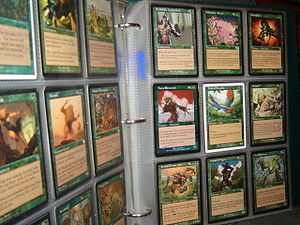
Card sleeve
Encyclopedia


Trading card
A trading card is a small card, usually made out of paperboard or thick paper, which usually contains an image of a certain person, place or thing and a short description of the picture, along with other text...
s from damage, especially collectible card game
Collectible card game
thumb|Players and their decksA collectible card game , also called a trading card game or customizable card game, is a game played using specially designed sets of playing cards...
cards from wear and tear. Thanks to the trading card industry, a wide variety of protective devices were developed, including the bulky "top-loader", a rigid plastic case with one open end (essentially a box for a single card) and the less-expensive simple "card sleeve," a card-sized envelope of clear plastic, with one end open. The term may also refer to 9-pocket pages designed to store trading cards in binders or card albums.
Once collectible card games became popular after the advent of Magic: The Gathering
Magic: The Gathering
Magic: The Gathering , also known as Magic, is the first collectible trading card game created by mathematics professor Richard Garfield and introduced in 1993 by Wizards of the Coast. Magic continues to thrive, with approximately twelve million players as of 2011...
, new technology was needed for two reasons. First of all, existing devices were not made with shuffling in mind: rigid top-loaders are effectively impossible to shuffle, and traditional card sleeves break easily during shuffling. Card sleeves also became all the more important because of Magic tournaments
Duelists' Convocation International
The DCI is the official sanctioning body for competitive play in Magic: The Gathering and various other games produced by Wizards of the Coast and its subsidiaries, such as Avalon Hill. The DCI provides game rules, tournament operating procedures, and other materials to private tournament...
: cards that were worn were considered to be marked, and could not be used in tournament decks. Furthermore, the card sleeves themselves were potentially a marking device: one drawback of traditional card sleeves was that they were typically slightly nonuniform, and therefore a potential way of marking cards in a deck on their own. Furthermore, the card sleeves themselves could become marked through wear. (This was a major problem with traditional card sleeves: they were typically a somewhat loose fit, and would develop creases at the sides.)
In 1995, the Ultra Pro company released the first card sleeves designed specifically for collectible card games, which they called deck protectors. Deck protectors were a tougher and more uniform version of traditional card sleeves, made of polypropylene
Polypropylene
Polypropylene , also known as polypropene, is a thermoplastic polymer used in a wide variety of applications including packaging, textiles , stationery, plastic parts and reusable containers of various types, laboratory equipment, loudspeakers, automotive components, and polymer banknotes...
, and specifically designed to snugly fit traditional cards. The first deck protectors were clear, but soon after, deck protectors were offered with opaque black backs, which would obscure the actual back of the card, allowing worn cards to be used without "marking" the deck. Other colors soon followed, and now a wide variety of deck protectors are available in many colors, and even with images on the back.
Today, players can get card sleeves specifically designed for other trading card games like Yu-Gi-Oh!
Yu-Gi-Oh!
is a Japanese manga created by Kazuki Takahashi. It has produced a franchise that includes multiple anime shows, a trading card game and numerous video games...
. With the popularity of card games in other countries, other companies such as Players' Choice, Dragon Shield, and Armor Shield have started making their own sleeves.
Modern tournament rules for most trading card games allow the use of card sleeves, and consider the card sleeves (if opaque) to be the real "back" of the card for the purposes of marking.
With the increasing popularity of board games such as Settlers of Catan, Ticket To Ride and Dominion, Mayday Games launched card sleeves specifically for Board Games in 2008. These card sleeves are now offered in 6 sizes and two thicknesses for over 500+ board games. In 2009 Fantasy Flight Games also entered the board-game card sleeve market with a line of premium thickness sleeves of its own.

